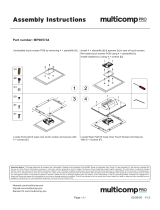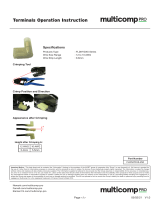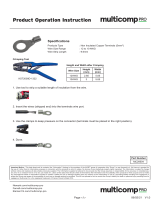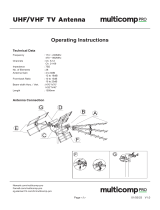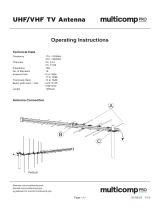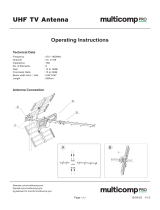
EVAL-ADM2582EEMIZ/EVAL-ADM2587EEMIZ User Guide
UG-916
One Technology Way • P. O. Box 9106 • Norwood, MA 02062-9106, U.S.A. • Tel: 781.329.4700 • Fax: 781.461.3113 • www.analog.com
2-Layer EN55022 Class A Radiated Emissions Compliant Evaluation Board for the
ADM2582E/ADM2587E 2.5 kV rms Signal and Power Isolated RS-485 Transceivers
with ±15 kV ESD Protection
PLEASE SEE THE LAST PAGE FOR AN IMPORTANT
WARNING AND LEGAL TERMS AND CONDITIONS.
Rev. 0 | Page 1 of 12
FEATURES
2.5 kV rms power and signal isolated RS-485/RS-422 transceiver
PCB layout optimized for EN55022 radiated emissions
according to the AN-1349 Application Note
ADM2587E passes EN55022 Class A (certification available)
ADM2582E passes EN55022 Class A (certification available)
2-layer printed circuit board (PCB) layout that minimizes PCB
material cost
Convenient connections for power and signal through screw
terminal blocks
Configurable as half-duplex or full-duplex
5 V or 3.3 V operation
Easily configurable through jumper connections
Test points for measuring all signals
EVALUATION KIT CONTENTS
EVAL-ADM2582EEMIZ or EVAL-ADM2587EEMIZ
DOCUMENTS NEEDED
AN-1349 Application Note
ADM2582E/ADM2587E data sheet
GENERAL DESCRIPTION
The ADM2582E/ADM2587E evaluation board can easily
evaluate the ADM2582E and ADM2587E power and signal
isolated RS-485/RS-422 transceivers. Screw terminal blocks
provide convenient connections for the power and signal
connections. The evaluation board is easily configured through
jumper connections. The board can be used in half-duplex or full-
duplex configurations and has a 120 Ω termination resistor
fitted on the receiver input. The evaluation board can be used
with either the ADM2582E 16 Mbps device or the ADM2587E
500 kbps device. The driver and receiver are enabled and disabled
by jumper connections. Test points are included on the power
and signal lines on both sides of the isolation barrier.
EN55022 RADIATED EMISSIONS
The ADM2582E/ADM2587E evaluation board is designed to
reduce emissions generated by the high frequency switching
elements used by the isoPower® technology to transfer power
through the ADM2582E/ADM2587E integrated transformer.
The layout of the evaluation board is generated using the
guidelines provided in the AN-1349 Application Note, PCB
Implementation Guidelines to Minimize Radiated Emissions on
the ADM2582E/ADM2587E RS-485/RS-422 Transceivers. The
ADM2587E and ADM2582E evaluation boards are tested and
certified to pass EN55022 Class A.
EVALUATION BOARD PHOTOGRAPH
14003-001
Figure 1.

UG-916 EVAL-ADM2582EEMIZ/EVAL-ADM2587EEMIZ User Guide
Rev. 0 | Page 2 of 12
TABLE OF CONTENTS
Features .............................................................................................. 1
Evaluation Kit Contents ................................................................... 1
Documents Needed .......................................................................... 1
General Description ......................................................................... 1
EN55022 Radiated Emissions ......................................................... 1
Evaluation Board Photograph ......................................................... 1
Revision History ............................................................................... 2
Evaluation Board Hardware ............................................................ 3
Test Setup ....................................................................................... 3
Jumper Settings ............................................................................. 3
Termination and Pull-Up/Pull-Down Resistors .......................4
Decoupling and Reservoir Capacitors ........................................4
Board Internal Layer Thickness ..................................................4
PCB Layout Reccomendations ....................................................4
EN55022 Radiated Emissions Test Results ................................5
Evaluation Board Schematics and Artwork ...................................8
Ordering Information .................................................................... 10
Bill of Materials ........................................................................... 10
Related Links ............................................................................... 11
REVISION HISTORY
5/2016—Revision 0: Initial Version

EVAL-ADM2582EEMIZ/EVAL-ADM2587EEMIZ User Guide UG-916
Rev. 0 | Page 3 of 12
EVALUATION BOARD HARDWARE
TEST SETUP
The ADM2582E/ADM2587E evaluation board is shown
in Figure 2 with the default jumper settings on the LK1 through
LK9 jumper blocks. In the default jumper connections, both the
ADM2582E/ADM2587E driver and receiver are enabled. Figure 2
also shows the power connection on the J2 terminal block, input
signal connection on the DI jack, and probes attached to the RXD,
DI, Y, and Z test points for a loopback test (LK5 and LK7 are
closed to connect A to Y pins and B to Z pins, respectively).
JUMPER SETTINGS
The inputs to the ADM2582E/ADM2587E can be configured
using the jumpers on the evaluation board (see Table 1). Do not
place multiple jumper blocks on the LK1, LK3, and LK6 jumper
blocks because the input sources may be shorted together. For
each link, a single jumper block can move from one position to
another, as specified in Table 1.
C
B
A
RxD
RE
DE
DI
RXD
RE
DE
DI
A
B
Z
Y
DI
A
B
Z
Y
LK5
GND1
SHIELD
GND2
VDD
J3
J2
J4
LK6
LK3
LK7
EVAL-ADM2582EEMIZ/87EEMIZ
OSCILLOSCOPE
SIGNAL
GENERATOR
GND
GND
LK1
LK9
C
B
A
C
B
A
14003-002
3.3V OR 5V
POWER
SUPPLY
Figure 2. Basic Operation of the EN55022 Class A Compliant Evaluation Board for the ADM2582E/ADM2587E Isolated RS-485/RS-422 Transceivers
Table 1. Jumper Configuration
Link Connection Description
LK1 A Connects the driver enable input (DE) of the ADM2582E/ADM2587E to V
CC
pin. This setting enables the driver.
B Connects the driver enable input (DE) of the ADM2582E/ADM2587E to the DE J3 terminal block connector.
C Connects the driver enable input (DE) of the ADM2582E/ADM2587E to GND
1
pin. This setting disables the driver.
LK6
A
Connects the receiver enable input (
RE
) of the ADM2582E/ADM2587E to V
CC
pin. This setting disables the receiver.
B Connects the receiver enable input (
RE
) of the ADM2582E/ADM2587E to the
RE
J3 terminal block connector.
C Connects the receiver enable input (
RE
) of the ADM2582E/ADM2587E to GND
1
pin. This setting enables the receiver.
LK3 Closed Connects the receiver enable input (
RE
) of the ADM2582E/ADM2587E to the driver enable input (DE). This setting
ensures that when the driver is enabled, the receiver is disabled, or when the driver is disabled, the receiver is enabled.
LK9 A Connects the TxD pin of the ADM2582E/ADM2587E to the DI connector.
B Connects the TxD pin of the ADM2582E/ADM2587E to the DI J3 terminal block connector.
C Connects the TxD pin of the ADM2582E/ADM2587E to the on-board oscillator circuit.
LK5 Closed Connects the ADM2582E/ADM2587E Receiver Input B to Driver Output Z. When LK5 and LK7 are both
connected, the evaluation board is configured for half-duplex operation.
Open When LK5 and LK7 are both open, the evaluation board is configured for full-duplex operation.
LK7 Closed Connects the ADM2582E/ADM2587E Receiver Input A to Driver Output Y. When LK5 and LK7 are both connected,
the evaluation board is configured for half-duplex operation.
Open When LK5 and LK7 are both open, the evaluation board is configured for full-duplex operation.

UG-916 EVAL-ADM2582EEMIZ/EVAL-ADM2587EEMIZ User Guide
Rev. 0 | Page 4 of 12
TERMINATION AND PULL-UP/PULL-DOWN
RESISTORS
The evaluation board includes the RT and RT1 footprints for
fitting termination resistors between the A and B receiver inputs
and the Y and Z driver outputs. By default, the board is not
fitted with a 120 Ω resistor, RT, between A and B. This resistor
must be removed if the board is connected to a bus that is
already terminated at both ends. For more information about
proper termination, see the AN-960 Application Note, RS-
485/RS-422 Circuit Implementation Guide.
Although the ADM2582E/ADM2587E have a built-in receiver
fail-safe for the bus idle condition, there are footprints on the
evaluation board for fitting the R9 and R10 pull-up resistors to
the V
ISOOUT
supply of the ADM2582E/ADM2587E on A and Y,
as well as the R7 and R8 pull-down resistors to GND
2
on B and Z.
These resistors can be fitted if the user is connecting to other
devices that require external biasing resistors on the bus. The
exact value required for a 200 mV minimum differential voltage
in the bus idle condition depends on the supply voltage (for
example, 960 Ω for 3.3 V and 1440 Ω for 5 V).
For more information about the bus idle fail-safe, see the AN-960
Application Note, RS-485/RS-422 Circuit Implementation Guide.
DECOUPLING AND RESERVOIR CAPACITORS
The evaluation board uses the following decoupling and
reservoir capacitors:
• On the logic side of the board, the C3 and C4 capacitors
must be 10 nF and 100 nF ceramic capacitors, respectively,
and the C2 capacitor must be a 10 µF tantalum capacitor.
• On the logic side of the board, the C7 capacitor must be a
100 nF ceramic capacitor, and the C9 capacitor must be a
10 µF tantalum capacitor.
• On the logic side of the board additional capacitors are
added for the power regulation circuits. C12, C13, and C16
must be a 10 µF tantalum capacitors, while C14 and C15
must be 100 nF ceramic capacitors.
• On the bus side of the board, the C5 and C6 capacitors
must be 10 nF and 100 nF, respectively, and the C1 and
C98 capacitors must be 100 nF and 10 µF, respectively.
BOARD INTERNAL LAYER THICKNESS
The ADM2582E/ADM2587E evaluation board consists of two
layers. The spacing between the top and bottom layer is 1.6 mm.
The E VA L -ADM2582EEMIZ and E VAL -ADM2587EEMIZ PCB
has a layer spacing of 0.4 mm between Layer 1 and Layer 2,
meeting requirements for isolation standards IEC 61010, third
edition, and IEC 60950 in the AN-1109 Application Note,
Recommendations for Control of Radiated Emissions with iCoupler
Devices.
PCB LAYOUT RECCOMENDATIONS
The ADM2582E/ADM2587E evaluation board is designed to
reduce emissions generated by the high frequency switching
elements used by the isoPower technology to transfer power
through the ADM2582E/ADM2587E integrated transformer.
The layout of the evaluation board is generated using the
guidelines provided in the AN-1349 Application Note.
The AN-1349 Application Note provides examples of 4-layer PCBs.
The EVA L-ADM2582EEMIZ and EVA L-ADM2587EEMIZ PCB
layout is a 2-layer PCB. To pass EN55022 Class A on a 2-layer
PCB, the following layout guidelines are recommended:
• Ensure that there is good decoupling on the PCB (see the
Decoupling and Reservoir Capacitors section).
• Place a ferrite bead between the PCB trace connections and
the following IC pins: V
ISOOUT
(Pin 12) and GND
2
(Pin 11
and Pin 14).
• Do not connect the V
ISOOUT
pin to a power plane;
connect between V
ISOOUT
and V
ISOIN
using a PCB trace.
Ensure V
ISOIN
(Pin 19) is connected through the L3 ferrite
to V
ISOOUT
(Pin 12) as shown in Figure 3.
• Place a high voltage discrete capacitor connected between
GND
1
(Pin 10) and GND
2
(Pin 11).The EVA L-
ADM2582EEMIZ requires a high voltage discrete capacitor
in order to pass EN 55022 Class A with adequate margin to
allow for test variation. However, the EVA L -ADM2587EEMIZ
can pass EN 55022 Class A without a high voltage discrete
capacitor. Adding a high voltage discrete capacitor to the
EVA L-ADM2587EEMIZ allows a larger pass margin from
the EN55022 Class A limits.
The following additional notes apply to the PCB layout; refer to
the schematic and artwork in Figure 10 to Figure 13.
• Ensure GND
2
(Pin 14) is connected to GND
2
(Pin 11) on
the inside (device side) of the C1 100 nF capacitor.
• Ensure the C1 capacitor is connected between V
ISOOUT
(Pin 12) and GND
2
(Pin 11) on the device side of the L2
and L3 ferrites.
• Ensure GND
2
(Pin 16) is connected to GND
2
(Pin 11) on
the outside (bus side) of the L2 ferrite as shown in Figure 3.
• Ensure that there is a keep out area for the GND
2
plane in
the PCB layout around the L2 and L3 ferrites. The keep
out area means there must not be a GND
2
fill on any layer
below the L2 and L3 ferrites.
• Ensure there is a minimum of 4 mm separation gap
between the GND
2
plane fill and the GND
2
fill for the C19
high voltage discrete capacitor pad.

EVAL-ADM2582EEMIZ/EVAL-ADM2587EEMIZ User Guide UG-916
Rev. 0 | Page 5 of 12
4mm MINIMUM GAP
BETWEEN GND2 PLANE
AND GND2 FILL FOR C19
“KEEP OUT”AREA
FOR L2 AND L3.
NO GND2 PLANE FILL
ON ANY PCB LAYER.
14003-003
Figure 3. Layout Notes for EVAL-ADM2582EEMIZ and EVAL-ADM2587EEMIZ
Locate the power delivery circuit in close proximity to the
ADM2587E/ADM2582E device, so the V
CC
trace is as
short as possible. The EVAL-ADM2582EEMIZ and
EVAL-ADM2587EEMIZ PCB has a power delivery circuit
located at the bottom of the PCB with a short trace from
the ADP667ARZ regulator output to V
CC
(Pin 8). This
layout example minimizes the loop area in which high
frequency current can flow. An increase in the loop area
results in an increase in the emissions levels.
EN55022 RADIATED EMISSIONS TEST RESULTS
The ADM2587E evaluation board is tested and certified to pass
EN55022 Class A with >6 dbμV margin. The ADM2582E
evaluation board is tested and certified to pass EN55022 Class A.
EN55022 Certification documents for the EVAL-ADM2582EEMIZ
and EVAL-ADM2587EEMIZ evaluation boards are available to
customers upon request from Analog Devices, Inc.
Table 3 provides a summary of the capability of the EVAL-
ADM2582EEMIZ and EVAL-ADM2587EEMIZ evaluation boards.
All EN55022 radiated emissions tests are performed with the PCB
schematic and layout as described in Figure 10 to Figure 13. The
C19 capacitor (See Figure 10) high voltage discrete capacitor is
removed for some tests. Table 2 describes the effect of removing or
adding the capacitor.
Table 2. EN55022 Test Results Summary
Device Configuration EN 55022 Result
ADM2587E C19 not fitted Pass Class A (3.9 dbμV margin)
ADM2582E C19 not fitted Pass Class A (1.2 dbμV margin)
ADM2582E C19 fitted
Pass Class A (with a larger 7.5 dbμV
margin)
The EVAL-ADM2582EEMIZ and EVAL-ADM2587EEMIZ
evaluation boards are configured and tested with 3.3 V V
CC
or
5.0 V V
CC
power supplied to the ADM2582E and ADM2587E
devices, with the power supplied from the ADP667ARZ regulator
output to V
CC
(Pin 8). The ADP667ARZ regulator input is supplied
from a standard 9 V battery. All EN55022 radiated emissions
testing is performed with 9 V batteries. Testing is performed at
500 kbps clock (ADM2587E) or 16 Mbps clock (ADM2582E),
with the clock supplied by the on-board oscillator. The
ADM2587E/ADM2582E transceiver is connected in full-duplex
mode and the bus pins are loaded with a 54 Ω termination resistor
(maximum bus loading). Measurements are carried out in an
anechoic chamber at 10 m from 30 MHz to 2 GHz. Figure 4 to
Figure 9 show the results of the worst case horizontal scans and
Table 3 to Table 8 show the tabulated quasi-peak (QP) results.
Table 3. ADM2587E 3.3V V
CC
Test Results (Not Using a High
Voltage Discrete Capacitor Between GND
1
and GND
2
)
Frequency
(MHz)
QP Level
dB (μV/m)
EN55022
Class A
dB (μV/m)
Antenna
Position
Antenna
Height (m) Pass/Fail
180.0040 26.7 40 Horizontal 4 Pass
358.4040 34.0 47 Vertical 3.5 Pass
359.9560 43.1 47 Horizontal 2.5 Pass
80
70
60
20
0
30 100 1000
EN55022
CLASS A
EN55022
CLASS B
14003-004
10
50
40
30
RADIATED EMISSIONS (dBµV/m)
FREQUENCY (MHz)
Figure 4. Horizontal Scan from 30 MHz to 1000 MHz
(Corresponds to Worst Case for Table 3)

UG-916 EVAL-ADM2582EEMIZ/EVAL-ADM2587EEMIZ User Guide
Rev. 0 | Page 6 of 12
Table 4. ADM2587E 5.0 V V
CC
Test Results (Not Using a
High Voltage Discrete Capacitor Between GND
1
and GND
2
)
Frequency
(MHz)
QP Level
dB (μV/m)
EN55022
Class A
dB (μV/m)
Antenna
Position
Antenna
Height (m)
Pass/Fail
199.9120 24.6 40 Horizontal 4 Pass
399.1040 43 47 Horizontal 4 Pass
399.1280 32.2 47 Vertical 3.5 Pass
80
70
60
20
0
30 100 1000
EN55022
CLASS A
EN55022
CLASS B
14003-005
10
50
40
30
FREQUENCY (MHz)
RADIATED EMISSIONS (dBµV/m)
Figure 5. Horizontal Scan from 30 MHz to 1000 MHz
(Corresponds to Worst Case for Table 4)
Table 5. ADM2582E 3.3V V
CC
Test Results (Not Using a High
Voltage Discrete Capacitor Between GND
1
and GND
2
)
Frequency
(MHz)
QP Level
dB (μV/m)
EN55022
Class A
dB (μV/m)
Antenna
Position
Antenna
Height (m) Pass/Fail
1978.996 27.7 40 Horizontal 4 Pass
356.948 45.8 47 Horizontal 2.5 Pass
357.060 35.3 47 Vertical 3.2 Pass
500.148 27.5 47 Horizontal 2 Pass
535.000 30.5 47 Horizontal 2 Pass
591.888 30.9 47 Horizontal 1.5 Pass
80
70
60
20
0
30 100 1000
EN55022
CLASS A
EN55022
CLASS B
14003-006
10
50
40
30
FREQUENCY (MHz)
RADIATED EMISSIONS (dBµV/m)
Figure 6. Horizontal Scan from 30 MHz to 1000 MHz
(Corresponds to Worst Case for Table 5)
Table 6. ADM2582E 5.0 V V
CC
Test Results (Not Using a
High Voltage Discrete Capacitor Between GND
1
and GND
2
)
Frequency
(MHz)
QP Level
dB (μV/m)
EN55022
Class A
dB (μV/m)
Antenna
Position
Antenna
Height (m) Pass/Fail
197.904 25.6 40 Horizontal 4 Pass
309.536 24.6 47 Horizontal 3 Pass
350.776 28.8 47 Horizontal 2.5 Pass
397.528 32.9 47 Vertical 3 Pass
397.676 42.3 47 Horizontal 2 Pass
426.356 20.5 47 Horizontal 2.5 Pass
456.100 19.3 47 Horizontal 3 Pass
462.036 36.4 47 Horizontal 1.5 Pass
497.816 20.2 47 Horizontal 2 Pass
568.904 27.5 47 Vertical 2 Pass
588.344 33.7 47 Horizontal 1.8 Pass
634.872 36.0 47 Horizontal 1.5 Pass
660.716 30.4 47 Horizontal 1.2 Pass
EN55022
CLASS A
EN55022
CLASS B
80
70
60
20
0
30 100 1000
14003-007
10
50
40
30
FREQUENCY (MHz)
RADIATED EMISSIONS (dBµV/m)
Figure 7. Horizontal Scan from 30 MHz to 1000 MHz
(Corresponds to Worst Case for Table 6)

EVAL-ADM2582EEMIZ/EVAL-ADM2587EEMIZ User Guide UG-916
Rev. 0 | Page 7 of 12
Table 7. ADM2582E 3.3 V V
CC
Test Results (Using a High
Voltage Discrete Capacitor Between GND
1
and GND
2
)
Frequency
(MHz)
QP Level
dB (μV/m)
EN55022
Class A
dB (μV/m)
Antenna
Position
Antenna
Height (m)
Pass/Fail
179.120 26.7 40 Horizontal 4 Pass
357.172 30.2 47 Horizontal 3 Pass
559.008 31.7 47 Horizontal 2 Pass
714.1080 27.4 47 Horizontal 1.2 Pass
892.448 33.3 47 Horizontal 1 Pass
80
70
60
20
0
30 100 1000
EN55022
CLASS A
EN55022
CLASS B
14003-008
10
50
40
30
FREQUENCY (MHz)
RADIATED EMISSIONS (dBµV/m)
Figure 8. Horizontal Scan from 30 MHz to 1000 MHz
(Corresponds to Worst Case for Table 7
Table 8. ADM2582E 5.0 V V
CC
Test Results (Using a High
Voltage Discrete Capacitor Between GND
1
and GND
2
)
Frequency
(MHz)
QP Level
dB (μV/m)
EN55022
Class A
dB (μV/m)
Antenna
Position
Antenna
Height (m)
Pass/Fail
197.740 23.6 40 Horizontal 4 Pass
344.228 28 47 Horizontal 3 Pass
394.000 30.1 47 Horizontal 2.5 Pass
425.216 31.6 47 Horizontal 2.2 Pass
465.760 32.8 47 Horizontal 2 Pass
492.064 32.2 47 Horizontal 2.5 Pass
496.700 32.8 47 Horizontal 1.8 Pass
532.980 25.3 47 Horizontal 2 Pass
537.196 28.5 47 Vertical 3 Pass
537.308 38.8 47 Horizontal 1.5 Pass
562.532 38.6 47 Horizontal 1.8 Pass
577.768 39.1 47 Horizontal 2 Pass
583.396 33.9 47 Horizontal 1.5 Pass
587.724 27.4 47 Vertical 2.5 Pass
588.056 39.5 47 Horizontal 1.5 Pass
603.648 33.5 47 Horizontal 1.5 Pass
608.236 39.0 47 Horizontal 1.5 Pass
80
70
60
20
0
30 100 1000
EN55022
CLASS A
EN55022
CLASS B
14003-009
10
50
40
30
FREQUENCY (MHz)
RADIATED EMISSIONS (dBµV/m)
Figure 9. Horizontal Scan from 30 MHz to 1000 MHz
(Corresponds to Worst Case for Table 8)

UG-916 EVAL-ADM2582EEMIZ/EVAL-ADM2587EEMIZ User Guide
Rev. 0 | Page 8 of 12
EVALUATION BOARD SCHEMATICS AND ARTWORK
POWER
1
GND
1
2
V
CC
3
GND1
4
RxD
5
RE
6
DE
7
TxD
8
V
CC
9
GND
1
10
GND
1
20
GND2
19
V
ISOIN
18
A
17
B
16
GND
22
15
Z
14
GND
2
13
Y
12
V
ISOOUT
11
GND
2
U1
ADM2582E_ADM2587E
1
DD
2
OUT
3
LBI
4
GND
8
IN
7
LBO
6
SET
5
SHDN
U2
ADP667ARZ
+
C2
10uF
3
C
2
B
1
A
R2
T93_POT
J2-1
J2-2
R3
240kΩ
R4
200kΩ
C7
100nF
C5
10nF
C6
100nF
+
C8
10µF
RT
* 120Ω DO NOT FIT *
RT1
*120Ω* DO NOT FIT
+
C9
10µF
C4
100nF
C3
10nF
+
C10
10uF
+
C16
10uF
+
C12
10µF
C14
100nF
C15
100nF
C17
100nF
C1
100nF
1 2
L3
1 2
L2
C13
10µF
J3-1
J3-2
J3-3
J3-4
A
B
C
LK6
A
B
C
LK1
1
V+
2
GND
3
SET
4
DIV
5
OUT
LTC1
LTC6900
LK3
R6
80.6kΩ
RXD
RE
DE
C18
100nF
DI_
DI
C19
* 100 pF * DO NOT FIT
J4-1
J4-2
J4-3
J4-4
J4-5
J4-6
LK5
LK7
R7
* 1.2kΩ
DO NOT FIT *
R8
* 1.2kΩ DO NOT FIT *
R9
* 1.2kΩ DO NOT FIT *
R10
* 1.2kΩ DO NOT FIT *
A
B
Y
Z
VDD
GND1
GND2
A
B
C
LK9
R11
*0Ω* SOLDER LINK
D2
R1
560Ω
D1
VDD
GND1
GND1
VDD
GND1
GND1
VDD
GND1
VDD
VDD
GND1
GND1
GND2
VISO
VISO
GND2
GND2
VISO
GND1
GND1
VDD
VCC
GND1
14003-010
Figure 10. Schematic of the ADM2582E/ADM2587E Evaluation Board

EVAL-ADM2582EEMIZ/EVAL-ADM2587EEMIZ User Guide UG-916
Rev. 0 | Page 9 of 12
14003-011
Figure 11. Top Layer
14003-012
Figure 12. Silkscreen
14003-013
Figure 13. Bottom Layer

UG-916 EVAL-ADM2582EEMIZ/EVAL-ADM2587EEMIZ User Guide
Rev. 0 | Page 10 of 12
ORDERING INFORMATION
BILL OF MATERIALS
Table 9. EVAL-ADM2582EEMIZ
Quantity Reference Designator Description Manufacturer Part Number
4 RR7, R8, R9, R10 Resistors, size 0805 (not inserted) Panasonic ERA6AEB122V
1 R11 Resistor, 0 Ω, size 0402 (not inserted) Multicomp MCMR04X000 PTL
1 RT Resistor, 120 Ω, size 0805 (not inserted) Yegeo RC0805JR-07120RL
1 RT1 Resistor, 120 Ω, size 0805 (not inserted) Yegeo RC0805JR-07120RL
3 C8, C9, C13 Capacitors, size 0805, 10 µF AVX 08056C106KAT2A
5 C4, C6, 14, C15, C17 Capacitors, size 0805, 100 nF Multicomp MC0805F104Z160CT
4 C2, C10, C12, C16 Capacitors, tantalum, 10 µF Kemet B45196E3106K309
3 C1, C7, C18 Capacitors, size 0603, 100 nF Yegeo CC0603KRX7R7BB104
2 C3, C5 Capacitors, size 0603, 10 nF AVX 0603YC103KAT2A
1
J2
Power connector, 2-pin terminal block
Camdenboss
CTB5000/2
1 J3 Connector, 4-pin terminal block Camdenboss CTB5000/4
1 J4 Connector, 6-pin terminal block Camdenboss CTB5000/6
1 LTC1 Oscillator LTC LTC6900CS5#TRMPBF
1 R1 Resistor, 0603, 1%, 560R Multicomp CRCW0603560RFKEAHP
1 R2 Trimmer, potentiometer, 500 kΩ, 23TURN Vishay T93YB504KT20
1 R3 Resistor, 0603, 240 kΩ, 5% Vishay CRCW0603240KFKEA
1 R4 Resistor, 0603, 200 kΩ, 5% Bourns CR0603-FX-2003ELF
1 R6 Resistor, 0603, 2.49 kΩ, 0.1% Multicomp MC0063W060312K49
3 LK1, LK6, LK9 6-pin (3 × 2), 2.54 mm header and shorting blocks Harwin M20-9983646 and M7566-05
3 LK3, LK5, LK7 2-pin (1 × 2), 2.54 mm header and shorting blocks Harwin M20-9990246
1
U1
20-lead, wide body SOIC
Analog Devices,
Inc.
ADM2582EBRWZ
1 U2 Adjustable voltage regulator Analog Devices,
Inc.
ADP667ARZ
2 LK2, LK3 Ferrite beads, 0402 Taiyo Yuden BKH1005LM182-T
1 DI SMA right hand jack TE Connectivity 5-1814400-1
1
D1
LED, SMD
Avago
HSMS-C191
1 D2 Schottky diode, 1 A, SMB ON Semiconductor MBRS130T3G
1 C19 Capacitor, ceramic, 1812 TDK C4532C0G3F101K160KA
11 RXD,
RE
, DE, DI, A, B, Z, Y,
VDD, GND1, GND2
Test points, yellow Vero 20-313140

EVAL-ADM2582EEMIZ/EVAL-ADM2587EEMIZ User Guide UG-916
Rev. 0 | Page 11 of 12
Table 10. EVAL-ADM2587EEMIZ
Quantity Reference Designator Description Manufacturer Part Number
4 RR7, R8, R9, R10 Resistors, size 0805 (not inserted) Panasonic ERA6AEB122V
1 R11 Resistor, 0 Ω, size 0402 (not inserted) Multicomp MCMR04X000 PTL
1 RT Resistor, 120 Ω, size 0805 (not inserted) Yegeo RC0805JR-07120RL
1 RT1 Resistor, 120 Ω, size 0805 (not inserted) Yegeo RC0805JR-07120RL
3 C8, C9, C13 Capacitors, size 0805, 10 µF AVX 08056C106KAT2A
5 C4, C6, 14, C15, C17 Capacitors, size 0805, 100 nF Multicomp MC0805F104Z160CT
4 C2, C10, C12, C16 Capacitors, tantalum, 10 µF Kemet B45196E3106K309
3 C1, C7, C18 Capacitors, size 0603, 100 nF Yegeo CC0603KRX7R7BB104
2 C3, C5 Capacitors, size 0603, 10 nF AVX 0603YC103KAT2A
1
J2
Power connector, 2-pin terminal block
Camdenboss
CTB5000/2
1 J3 Connector, 4-pin terminal block Camdenboss CTB5000/4
1 J4 Connector, 6-pin terminal block Camdenboss CTB5000/6
1 LTC1 Oscillator LTC LTC6900CS5#TRMPBF
1 R1 Resistor, 0603, 1%, 560R Multicomp CRCW0603560RFKEAHP
1 R2 Trimmer, POT, 500 kΩ, 23TURN Vishay T93YB504KT20
1 R3 Resistor, 0603, 240 kΩ, 5% Vishay CRCW0603240KFKEA
1 R4 Resistor, 0603, 200 kΩ, 5% Bourns CR0603-FX-2003ELF
1 R6 Resistor, 0603, 2.49 kΩ, 0.1% TE Connectivity RP73D1J80K6BTDG
3 LK1, LK6, LK9 6-pin (3 × 2), 2.54 mm header and shorting blocks Harwin M20-9983646 and M7566-05
3 LK3, LK5, LK7 2-pin (1 × 2), 2.54 mm header and shorting blocks Harwin M20-9990246
1
U1
20-lead, wide body SOIC
Analog Devices, Inc.
ADM2587EBRWZ
1 U2 Adjustable voltage regulator Analog Devices, Inc. ADP667ARZ
2 LK2, LK3 Ferrite beads, 0402 Taiyo Yuden BKH1005LM182-T
1 DI SMA right hand jack TE Connectivity 5-1814400-1
1 D1 LED, SMD Avago HSMS-C191
1 D2 Schottky diode, 1 A, SMB ON Semiconductor MBRS130T3G
1
C19
Capacitor, ceramic, 1812
TDK
C4532C0G3F101K160KA
11 RXD,
RE
, DE, DI, A, B, Z, Y,
VDD, GND1, GND2
Test points, yellow Vero 20-313140
RELATED LINKS
Resource Description
ADM2587E 500 kbps, 2.5 kV rms signal and power isolated RS-485/RS-422 transceivers with ±15 kV ESD Protection
ADM2582E 16 Mbps, 2.5 kV rms signal and power Isolated RS-485/RS-422 transceivers with ±15 kV ESD Protection
AN-1349
PCB Implementation Guidelines to Minimize Radiated Emissions on the ADM2582E/ADM2587E RS-485/RS-422 Transceivers
AN-960
RS-485/RS-422 Circuit Implementation Guide
AN-1109
Recommendations for Control of Radiated Emissions with iCoupler® Devices

UG-916 EVAL-ADM2582EEMIZ/EVAL-ADM2587EEMIZ User Guide
Rev. 0 | Page 12 of 12
NOTES
ESD Caution
ESD (electrostatic discharge) sensitive device. Charged devices and circuit boards can discharge without detection. Although this product features patented or proprietary protection
circuitry, damage may occur on devices subjected to high energy ESD. Therefore, proper ESD precautions should be taken to avoid performance degradation or loss of functionality.
Legal Terms and Conditions
By using the evaluation board discussed herein (together with any tools, components documentation or support materials, the “Evaluation Board”), you are agreeing to be bound by the terms and conditions
set forth below (“Agreement”) unless you have purchased the Evaluation Board, in which case the Analog Devices Standard Terms and Conditions of Sale shall govern. Do not use the Evaluation Board until you
have read and agreed to the Agreement. Your use of the Evaluation Board shall signify your acceptance of the Agreement. This Agreement is made by and between you (“Customer”) and Analog Devices, Inc.
(“ADI”), with its principal place of business at One Technology Way, Norwood, MA 02062, USA. Subject to the terms and conditions of the Agreement, ADI hereby grants to Customer a free, limited, personal,
temporary, non-exclusive, non-sublicensable, non-transferable license to use the Evaluation Board FOR EVALUATION PURPOSES ONLY. Customer understands and agrees that the Evaluation Board is provided
for the sole and exclusive purpose referenced above, and agrees not to use the Evaluation Board for any other purpose. Furthermore, the license granted is expressly made subject to the following additional
limitations: Customer shall not (i) rent, lease, display, sell, transfer, assign, sublicense, or distribute the Evaluation Board; and (ii) permit any Third Party to access the Evaluation Board. As used herein, the term
“Third Party” includes any entity other than ADI, Customer, their employees, affiliates and in-house consultants. The Evaluation Board is NOT sold to Customer; all rights not expressly granted herein, including
ownership of the Evaluation Board, are reserved by ADI. CONFIDENTIALITY. This Agreement and the Evaluation Board shall all be considered the confidential and proprietary information of ADI. Customer may
not disclose or transfer any portion of the Evaluation Board to any other party for any reason. Upon discontinuation of use of the Evaluation Board or termination of this Agreement, Customer agrees to
promptly return the Evaluation Board to ADI. ADDITIONAL RESTRICTIONS. Customer may not disassemble, decompile or reverse engineer chips on the Evaluation Board. Customer shall inform ADI of any
occurred damages or any modifications or alterations it makes to the Evaluation Board, including but not limited to soldering or any other activity that affects the material content of the Evaluation Board.
Modifications to the Evaluation Board must comply with applicable law, including but not limited to the RoHS Directive. TERMINATION. ADI may terminate this Agreement at any time upon giving written notice
to Customer. Customer agrees to return to ADI the Evaluation Board at that time. LIMITATION OF LIABILITY. THE EVALUATION BOARD PROVIDED HEREUNDER IS PROVIDED “AS IS” AND ADI MAKES NO
WARRANTIES OR REPRESENTATIONS OF ANY KIND WITH RESPECT TO IT. ADI SPECIFICALLY DISCLAIMS ANY REPRESENTATIONS, ENDORSEMENTS, GUARANTEES, OR WARRANTIES, EXPRESS OR IMPLIED, RELATED
TO THE EVALUATION BOARD INCLUDING, BUT NOT LIMITED TO, THE IMPLIED WARRANTY OF MERCHANTABILITY, TITLE, FITNESS FOR A PARTICULAR PURPOSE OR NONINFRINGEMENT OF INTELLECTUAL
PROPERTY RIGHTS. IN NO EVENT WILL ADI AND ITS LICENSORS BE LIABLE FOR ANY INCIDENTAL, SPECIAL, INDIRECT, OR CONSEQUENTIAL DAMAGES RESULTING FROM CUSTOMER’S POSSESSION OR USE OF
THE EVALUATION BOARD, INCLUDING BUT NOT LIMITED TO LOST PROFITS, DELAY COSTS, LABOR COSTS OR LOSS OF GOODWILL. ADI’S TOTAL LIABILITY FROM ANY AND ALL CAUSES SHALL BE LIMITED TO THE
AMOUNT OF ONE HUNDRED US DOLLARS ($100.00). EXPORT. Customer agrees that it will not directly or indirectly export the Evaluation Board to another country, and that it will comply with all applicable
United States federal laws and regulations relating to exports. GOVERNING LAW. This Agreement shall be governed by and construed in accordance with the substantive laws of the Commonwealth of
Massachusetts (excluding conflict of law rules). Any legal action regarding this Agreement will be heard in the state or federal courts having jurisdiction in Suffolk County, Massachusetts, and Customer hereby
submits to the personal jurisdiction and venue of such courts. The United Nations Convention on Contracts for the International Sale of Goods shall not apply to this Agreement and is expressly disclaimed.
©2016 Analog Devices, Inc. All rights reserved. Trademarks and
registered trademarks are the property of their respective owners.
UG14003-0-5/16(0)

Mouser Electronics
Authorized Distributor
Click to View Pricing, Inventory, Delivery & Lifecycle Information:
Analog Devices Inc.:
EVAL-ADM2587EEMIZ EVAL-ADM2582EEMIZ
/
